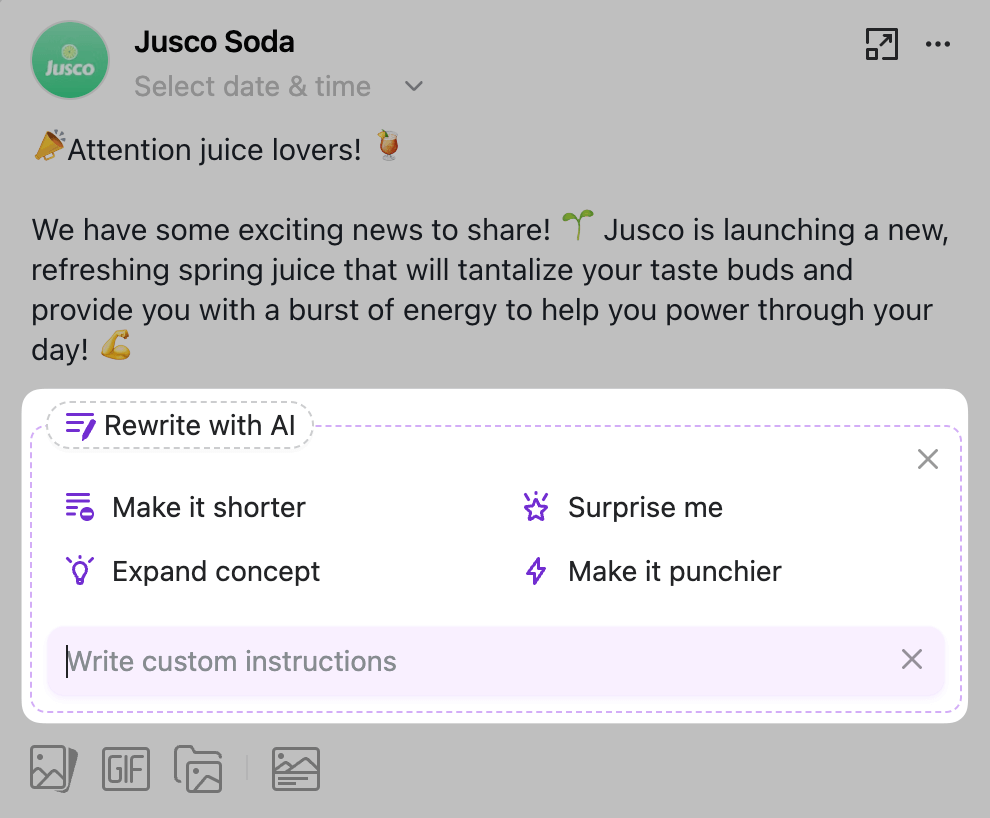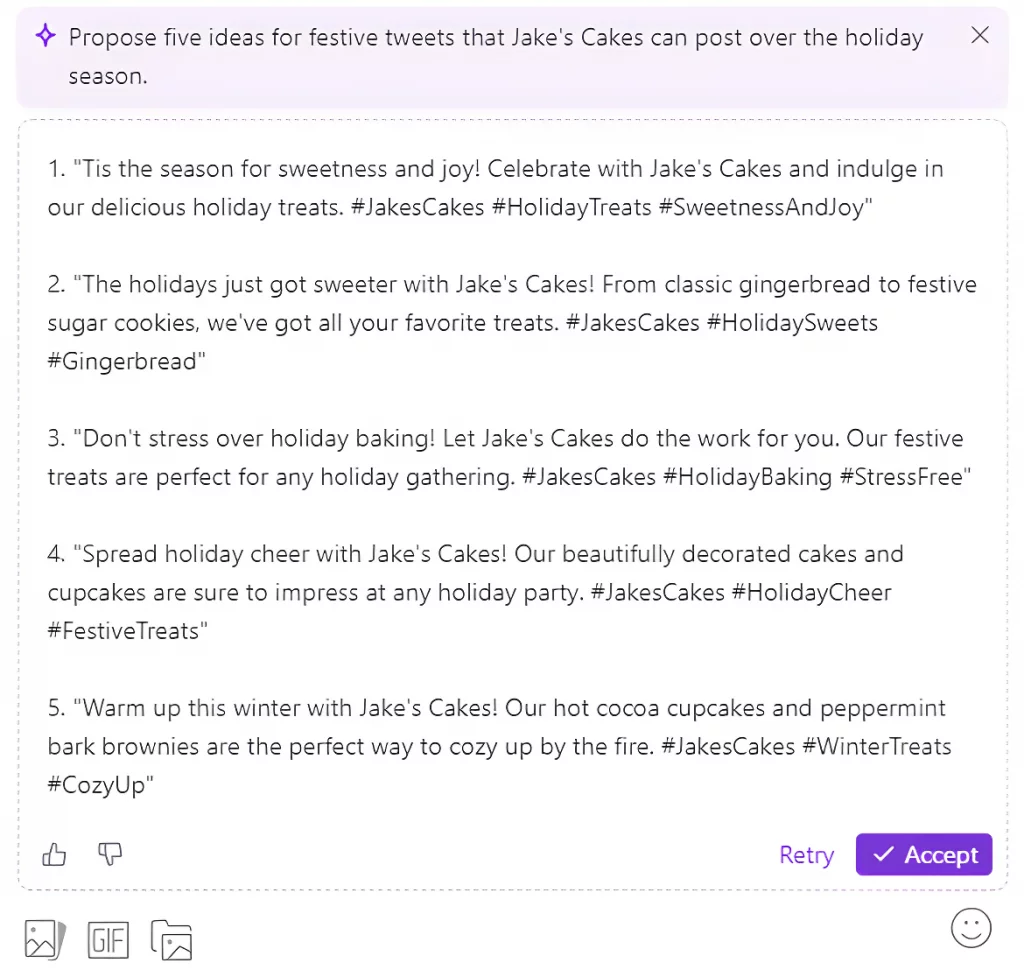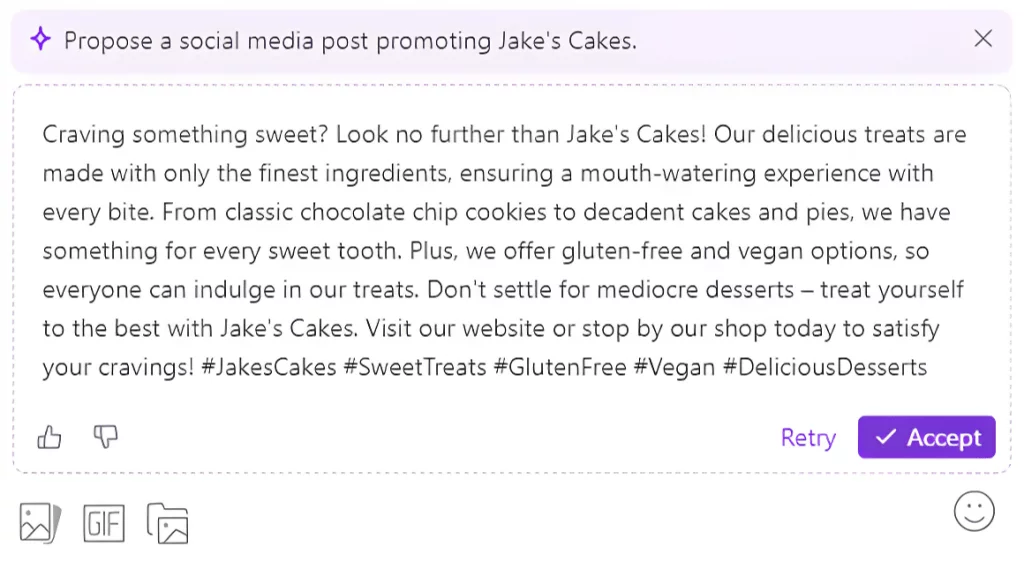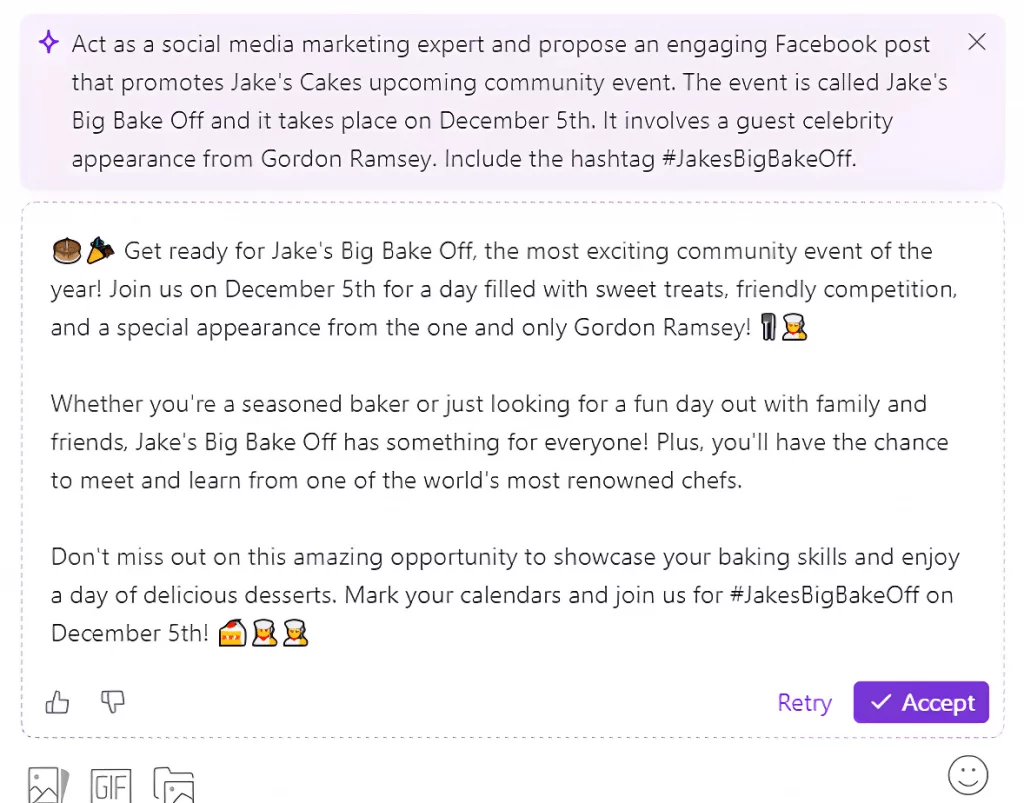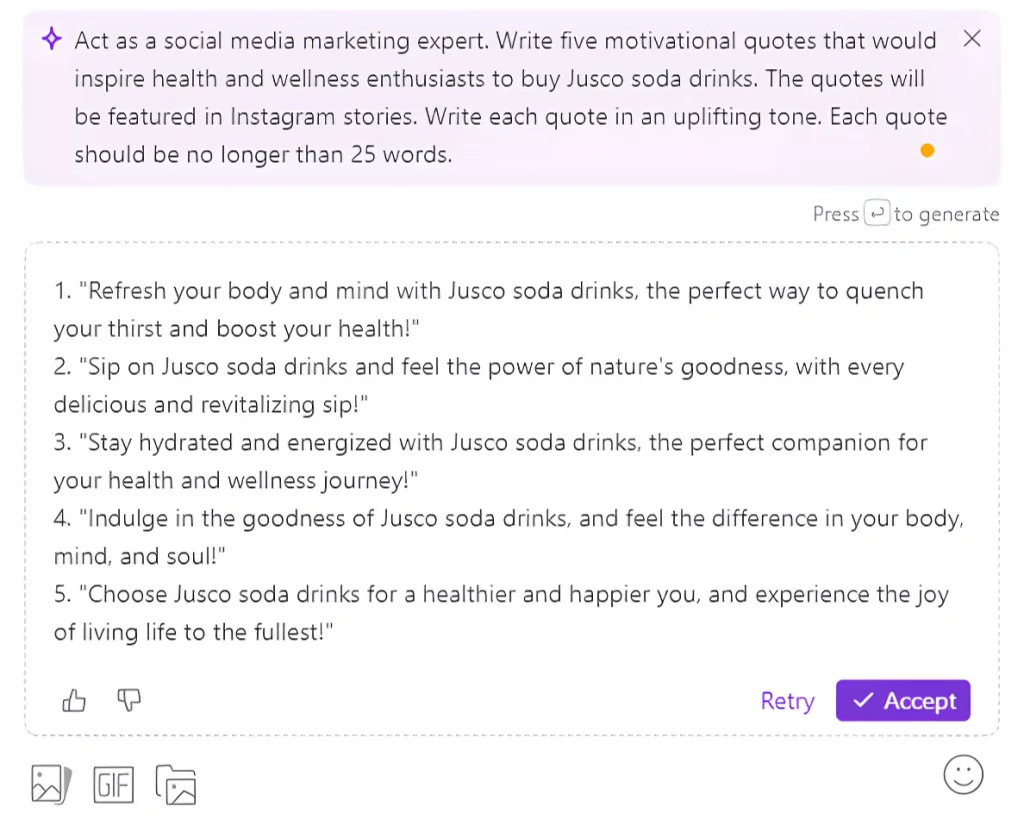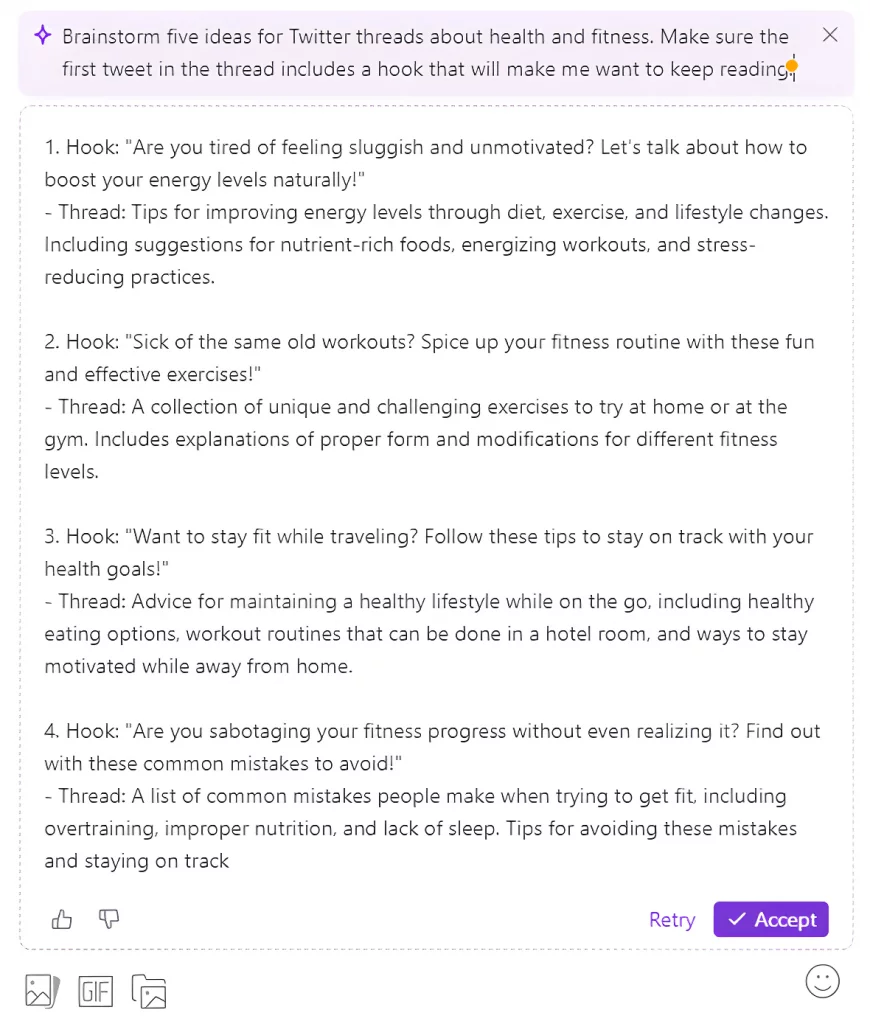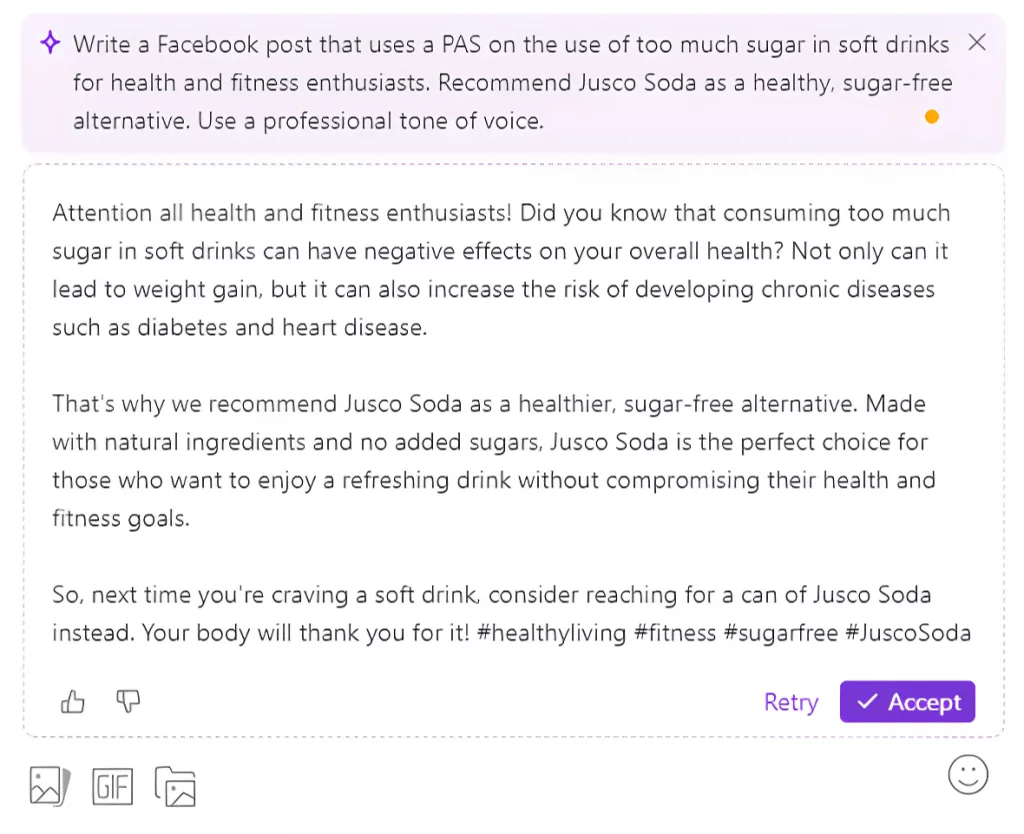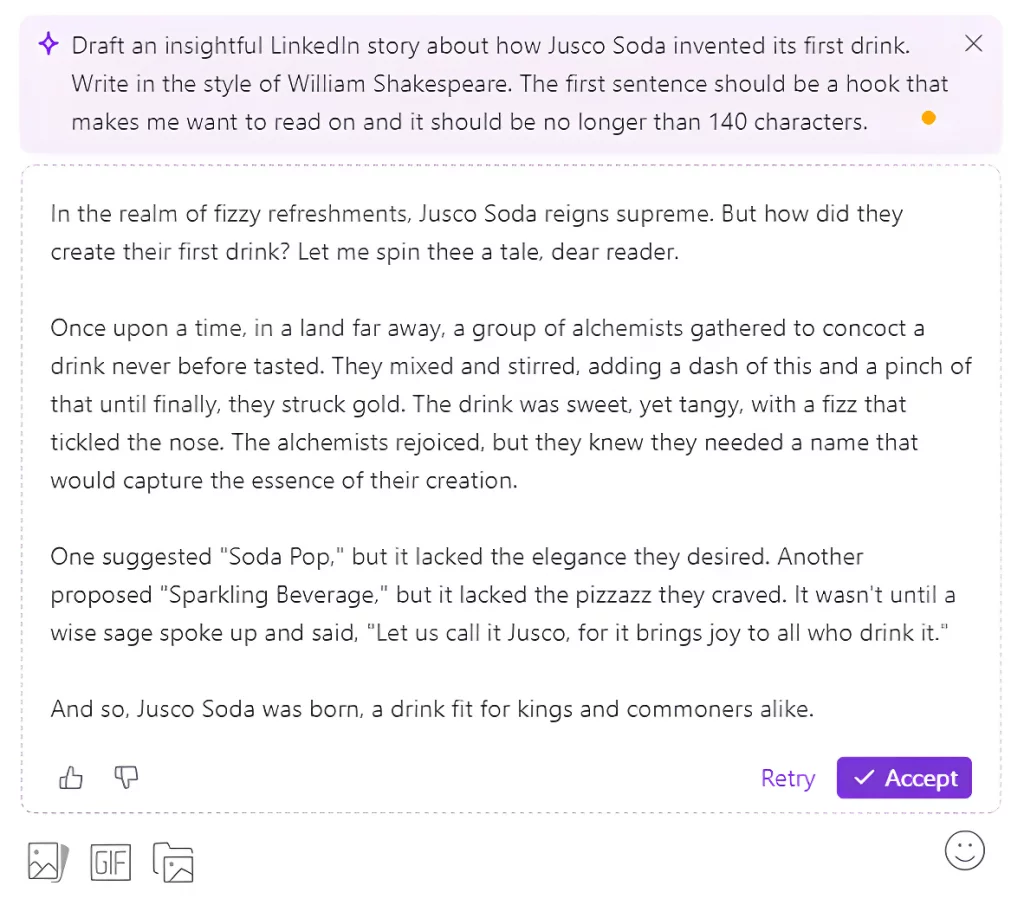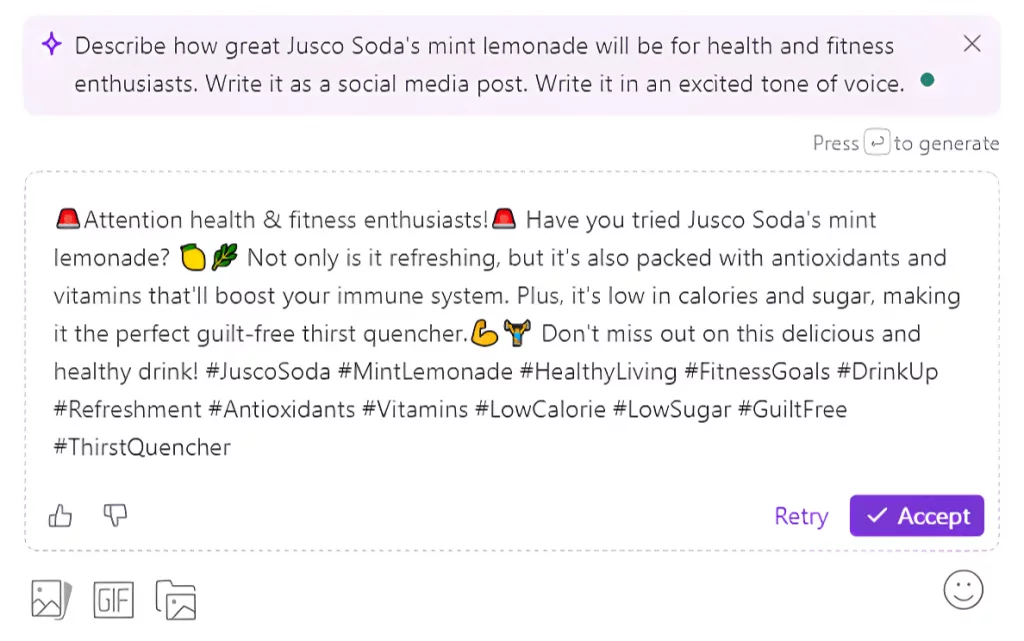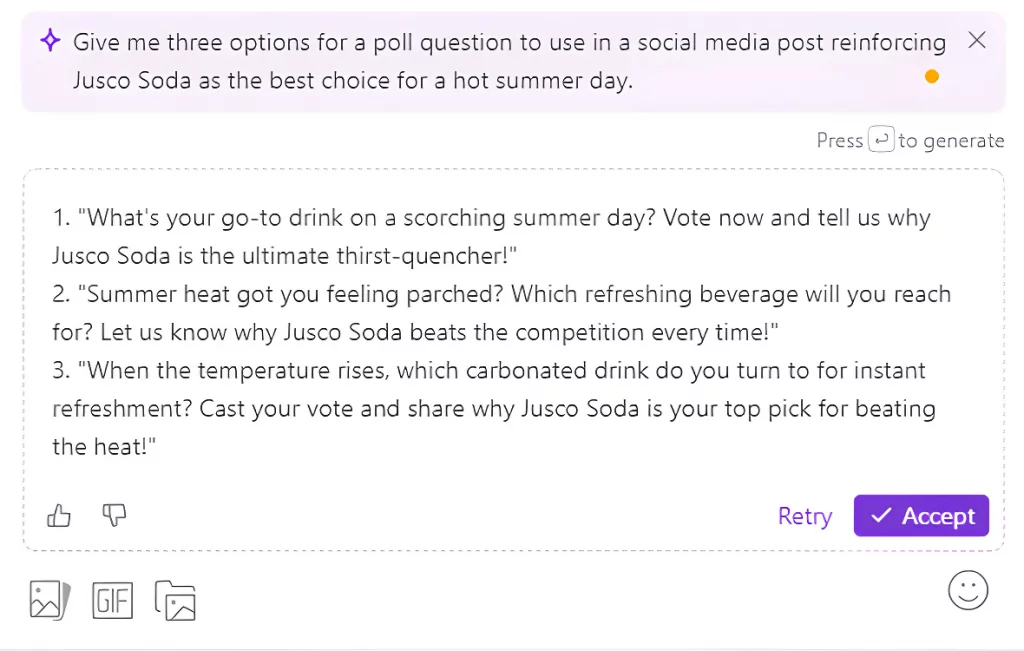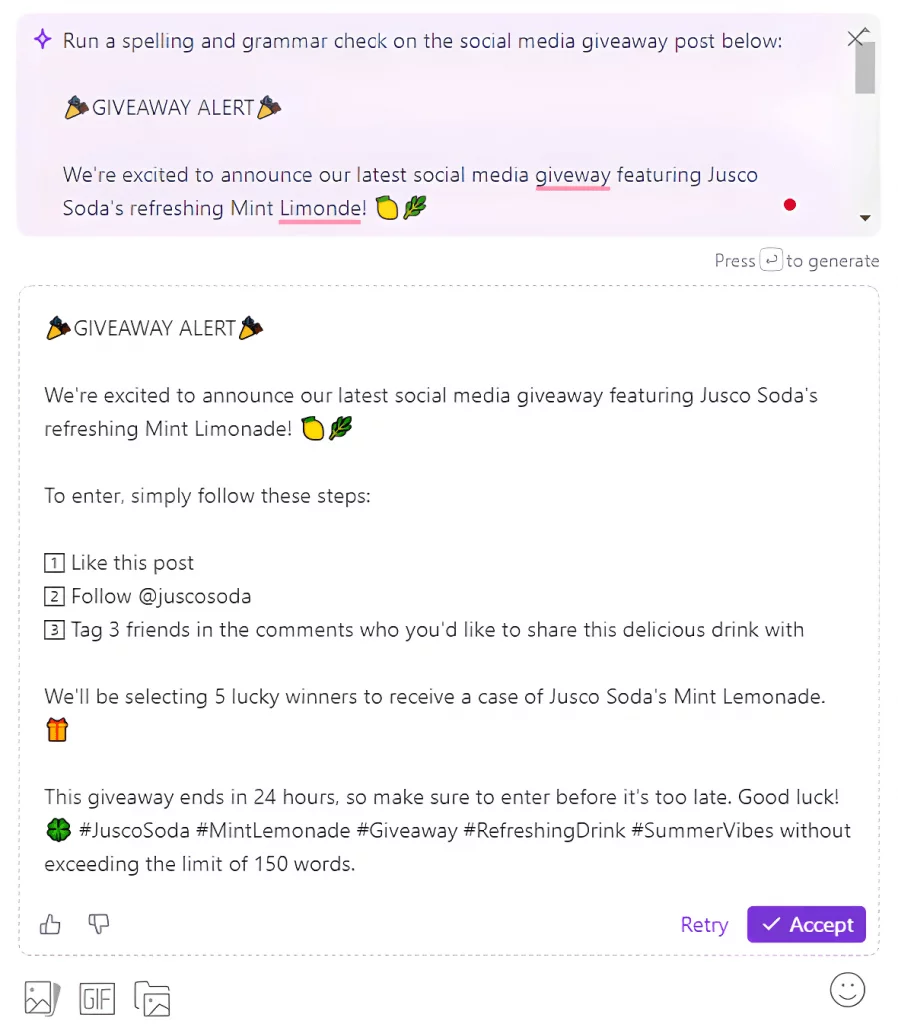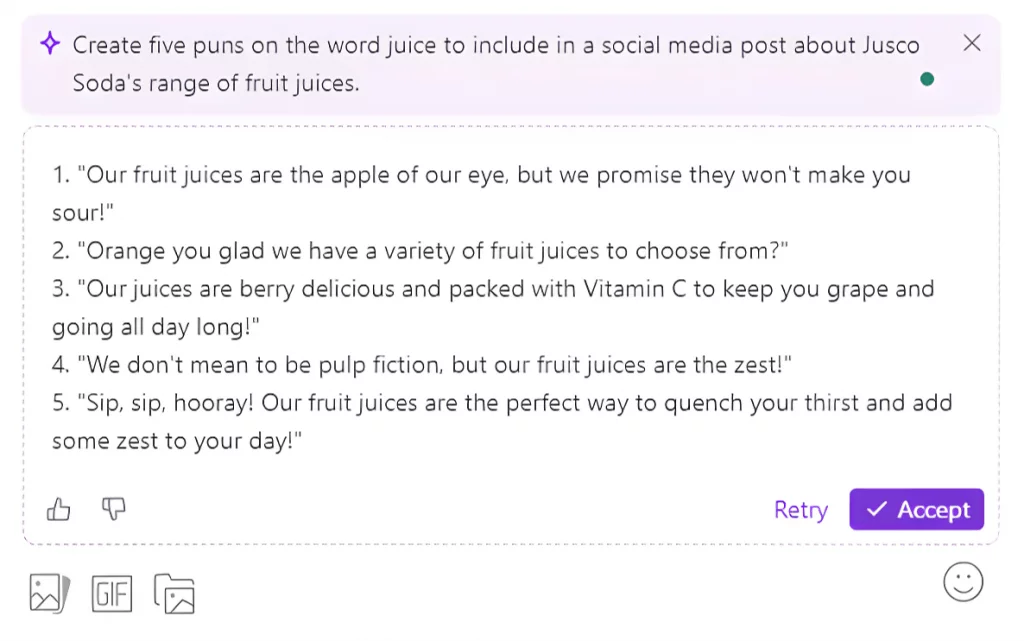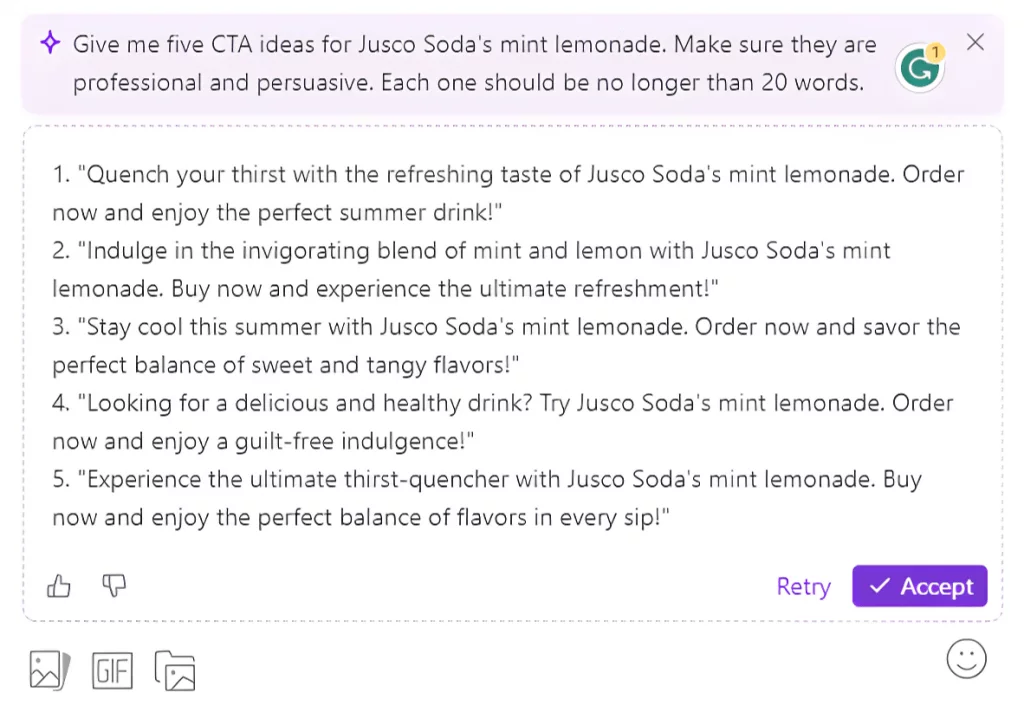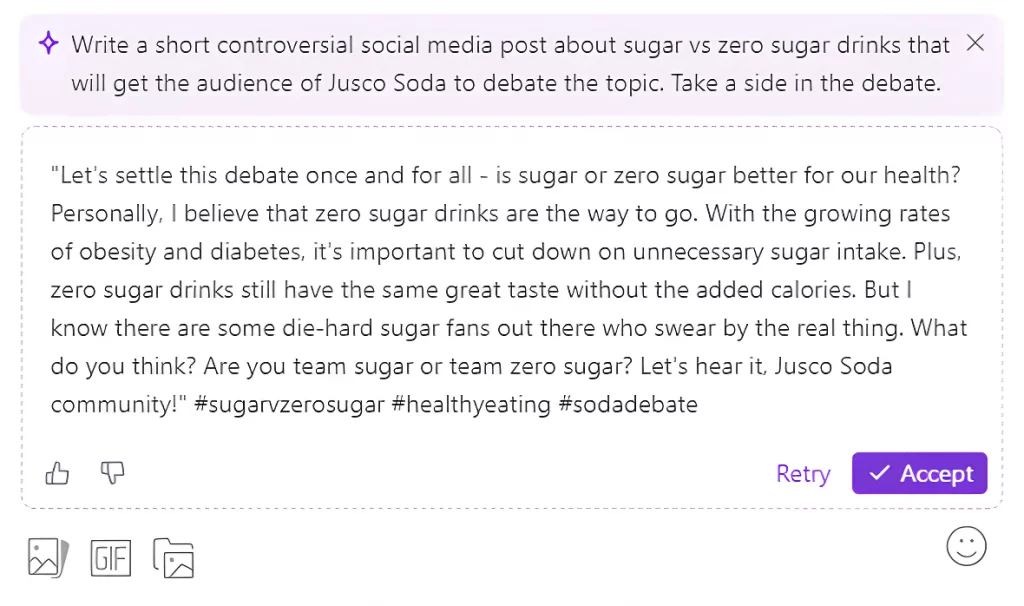Struggling to find inspiration for your next set of social posts? Well, you may find that AI prompts for social media are just what you need to fill that blank page in front of you with a whole bunch of new ideas.
Artificial intelligence tools have taken the world by storm over the last few months. And for good reason. Tasks that used to take hours are now finished in just a few minutes.
You’ve probably seen the hype all over social media. The results AI tools can produce are blowing people away. Although, there are also plenty of examples where AI completely misses the mark.
The difference between “omg that’s amazing 🤩” and “omg… that’s not right 😐” is usually a well-crafted prompt.
In this article, you’ll learn how to structure AI prompts to fill out that social media calendar of yours with some fantastic ideas.
Plus, I’ll get you started with 50 prompts that you can try for your brand!
Let’s get to it.
Contents
What are AI prompts for social media?
An AI prompt for social media is an instruction given to an AI tool to generate social media content. AI prompts help social media marketers brainstorm new post ideas, see alternative versions of drafts, or even create entire posts.
For example, one of Planable’s new AI features comes with four preset prompts when you want to rewrite a post:
- Make it shorter – for when you need to keep things more concise and to the point.
- Make it punchier – for when the text really needs to grab your audience’s attention.
- Expand concept – to delve deeper into the topic and add more information.
- Surprise me – to get a completely fresh perspective on your post.
All four of these are examples of an AI prompt because in each case you are (quite literally) prompting the tool to follow the instruction.
How social media teams can use AI prompts
Are you even a social media marketer if you haven’t run out of creative juice when brainstorming ideas? Or felt just a little bit frustrated when playing around with phrasing to get that next tweet under the character limit?
It’s at times like these when a fresh perspective can be a lifesaver. Something to bounce ideas off, rather than bouncing your head off the wall.
AI tools can help you overcome these situations in seconds. With a short prompt, you’ll be back on track with killer content creation that keeps your social media presence on point.
Here are a just few ways that AI tools can help.
Generate new content ideas
An AI prompt can save you a lot of time and stress when thinking of new social media post ideas.
Let’s say you’re doing some work for a new client. It’s a local bakery called Jake’s Cakes.
(Yes, I just wanted the name to rhyme.)
It’s late November, so you know what that means. Holiday season. It’s here and it’s in full flow.
You need to come up with some awesome tweets, but all you can think of right now are totally awful puns.
Merry Cakemas? Seriously? What were you thinking?
You just need a little spark, something to give your brain a nudge in the right direction.
Well, the right prompt can help you generate ideas and kickstart the content creation process.
Here’s how it looks in Planable:
Find the right phrasing
Every word matters when you create content. So, it’s understandable that sometimes we can spend a few hours minutes agonizing over how to phrase something.
Maybe you have the core idea of a social media post already. You’re confident about the overall message, but something doesn’t feel right. Or you just can’t quite find the perfect way to finish it off.
This is where AI copywriting tools come in handy. Turn to AI to help you get over that final hump. You can give the tool what you have so far and ask it for suggestions. It’s a great way to get some outside-the-box thinking into your social media posts.
And remember, if you’re not happy with the proposals, the retry button is your friend. You can also make a few small tweaks to your prompt to get slightly different outputs.
Rewrite drafts or repurpose old posts
When you have a finished draft for a social media post, that doesn’t necessarily mean it’s ready to go live. It needs to go through a feedback and approval process to make sure that it aligns with your brand’s social media strategy.
Occasionally, the feedback may require a rewrite.
When this happens, AI prompts can help you implement the changes quickly. For example, you may have feedback on a post that says the message is good but the tone of voice needs to be more professional.
In this situation, you can provide the original draft to the AI tool and ask it to rewrite the post in the correct tone. You can even ask for multiple versions so that you have options to choose from.
This can also be useful when you’re looking at ways to repurpose an existing post to other social media platforms. If you have a YouTube video script that you want to turn into a Twitter thread, you can get suggestions on how to do just that.
Bonus tip 1: you can use an AI prompt to paraphrase engaging content from another brand or to propose a social media post from a snippet of a blog post.
Bonus tip 2: a paraphrase prompt is great when you need variations of the same post for different team members to use when sharing new content.
How to structure an AI prompt for the best results
It’s not easy to consistently create content that really resonates with your audience. AI tools are a big help, but there are still things to consider when creating your prompts. After all, you want to get the best possible outputs that will add value to your social media marketing efforts.
With that in mind, here are a few tips on how to structure your prompts in order to get the best results.
Provide context
As a content marketer, I’ve lost count of the number of articles that told me ‘content is king’. In the age of artificial intelligence, that saying may well become ‘context is king’.
Why?
It’s simple. When you provide an AI tool with more context about what you want, it will be able to create content that more closely matches your expectations.
Say you want a pepperoni pizza with extra cheese on a thick crust. You wouldn’t just call up your local pizza place and say “Yo, gimme one of those pizzas.”
I mean, I guess you could but the chance of you getting what you want is pretty slim. You would need to be specific so that you get the right pizza.
AI prompts work in pretty much the same way. If you provide more context to help the tool understand your goal and preferences, then you are way more likely to get a response that you’re happy with.
Keep the following points in mind when writing your prompts and you will see much better outputs.
1. Be specific
When you want an AI tool to help you with a social media post, make sure to give it some specifics. For example, should it add hashtags or emojis? Do you want it to create a list? Make sure this is clear in your prompt.
You should also be specific when defining the length of a post. Asking for “a fairly short promotional LinkedIn post” leaves too much room for interpretation of what fairly short means. Instead, you can ask for “a promotional LinkedIn post that is 2-3 sentences long”.
2. Establish the format
Each social media platform has certain formats that work well. A funny tweet has a completely different format from an inspirational LinkedIn post. Be sure to instruct the AI tool on how you want it to write as well as what you want it to write.
3. Be as detailed and descriptive as possible
Try to give the tool as much key information as you can. There’s a big difference between the output you will receive when you provide a basic prompt versus one with extra detail.
A basic prompt might be something like:
“Propose a social media post promoting Jake’s Cakes”.
A prompt with more detail could be:
“Act as a social media marketing expert and propose an engaging Facebook post that promotes Jake’s Cakes upcoming community event. The event is called Jake’s Big Bake Off and it takes place on December 5th. It involves a guest celebrity appearance from Gordon Ramsey. Include the hashtag #JakesBigBakeOff.”
However, it is also important to avoid unnecessary information, so make sure not to include extra detail for the sake of it.
Define the tone of voice
The social media presence of every brand is different. It feels different.
You would never confuse a Chipotle tweet for a Visa tweet. Even if I hid the logos and all you saw were the messages, you’d know which was which.
That’s largely down to the established tone of voice that each brand uses on the platform.
In your ai content strategy, when crafting your prompts, it’s important that your brand’s tone of voice remains consistent. Be clear on how you want the response to sound.
Going for a more inspirational social media message? Great. Tell the AI tool to make it sound uplifting or to use a hopeful tone of voice. This will ensure that the generated content aligns with what you have in mind.
Set limitations
It would be fair to expect that AI tools understand social media platforms to a certain extent. If you ask for a series of Twitter posts, all of the outputs will fall within the standard 280-character limit, right?
Well, no actually. You will occasionally receive tweet recommendations in excess of 500 characters.
Similarly, when requesting a LinkedIn post, an AI tool may not take into account that the platform cuts off messages after 140 characters. That’s when the ‘see more’ button shows up.
So, if you want to ensure that platform-specific details like this are taken into account, you should set limitations as part of your prompt.
For example, a prompt for a LinkedIn story could add the instruction to “Limit the opening line to 20 words and include a hook that makes me want to read on.”
Another type of limitation that you can set is to exclude a word or phrase. Sometimes, brand guidelines prevent you from using certain language because it’s part of a competitor’s core messaging.
In any situation like this, ensure the AI tool understands not to use the term.
Ask for multiple versions
One of the most important tips to keep in mind is to always ask for several variations. Whether you are coming up with ideas for new social media posts in the early stages of the content creation process, or trying to put that final touch on a draft, it’s always better to see more than one version.
It’s super simple to do this too. Whenever you write an AI prompt, instead of asking for a singular output like “Write a catchy Facebook post”, aim for multiple outputs with a prompt like “Propose five versions of a catchy Facebook post.”
50 helpful AI prompts for social media teams to try
Here you will find a comprehensive list of 50 prompts for different types of social media posts. I tested every single one with Planable’s new AI feature and 10 of them come with a screenshot so you can see exactly how the tool responded.
You can try them as they are by adding your own details in the appropriate places, or use them as guidelines to help you create your own prompts from scratch.
AI prompts for inspirational Instagram posts
1. Act as a social media marketing expert. Write five motivational quotes that would inspire [insert your target audience] to [insert the desired action]. The quotes will be featured in Instagram stories. Write each quote in an uplifting tone. Each quote should be no longer than 25 words.
2. Propose five ideas for inspiring Instagram reels with viral potential. The proposals should appeal to [insert your target audience] and help to promote [insert your product/brand].
3. Write an inspirational Instagram caption about [insert your topic] that will engage the target audience [insert your audience]. The first sentence should include a hook that makes me want to keep reading. Give me five options.
4. Generate three versions of an inspiring social media post. It should be an Instagram caption for a picture of [insert your product/topic] that will engage [insert your target audience]. The caption should be no longer than 1-2 sentences. Include relevant hashtags to help the caption stand out.
5. Below is a proposal for an Instagram caption. Give me three different options with a more inspirational tone.
[insert your proposal]
AI prompts for Twitter threads
6. Brainstorm five ideas for Twitter threads about [insert your topic]. Make sure the first tweet in the thread includes a hook that will make me want to keep reading.
7. Explain the benefits of [insert your topic] for [insert your target audience]. Format the response as a Twitter thread where each tweet covers one benefit. In the final tweet, include a call to action that will drive people to our website at [insert your website].
8. Summarize the information below into a Twitter thread that will be engaging for [insert your target audience].
9. Translate the following bullet points into a Twitter thread in Spanish. Make each tweet informative and engaging.
10. Suggest five alternative ways to phrase this opening hook for a Twitter thread.
[insert your opening hook]
AI prompts for engaging Facebook posts
11. Write a Facebook post that uses a PAS on the [insert pain point] for [insert your target audience]. Recommend [insert your brand] as an alternative. Use a professional tone of voice.
12. Craft an engaging Facebook post that asks our audience to share their favorite memory related to [insert your brand]. Write it in an enthusiastic tone of voice.
13. Describe the impact of using [insert your product/service] as part of a daily routine. Format it as a Facebook post. Include a hook in the first sentence. Use a positive tone of voice.
14. Create a list of pros and cons about [insert your topic]. Write it in a thoughtful tone of voice.
15. Paraphrase this LinkedIn story into a post that will engage [insert your target audience] on Facebook.
AI prompts for insightful LinkedIn posts
16. Draft an insightful LinkedIn story about [insert your topic] in the style of [insert famous author]. The first sentence should be a hook that makes me want to read on and it should be no longer than 140 characters.
17. Compose an insightful LinkedIn post promoting best practices within [insert your topic/industry]. Write it in a professional tone of voice.
18. Propose five insightful hooks that will make me want to read more about [insert topic] on LinkedIn. Each hook should include no more than 20 words.
19. Suggest five alternatives to the draft copy below. It is for a LinkedIn post. Make the tone of voice more thought-provoking.
[insert draft copy]
20. Act as a social media marketing expert. Recommend a LinkedIn post to announce a new blog post on [insert your topic]. Include a persuasive call to action to drive people to the blog post.
AI prompts for product launch posts
21. Describe how great [insert your new product] will be for [insert your target audience]. Write it as a social media post. Write it in an excited tone of voice.
22. Produce a social media post talking about [insert the URL of your product launch press release].
23. Summarize the text below into 2-3 sentences that will make me want to know more about [insert your new product].
24. Rewrite the social media announcement below in a witty tone of voice. Include emojis and hashtags to make it stand out.
[insert your draft announcement]
25. Suggest five hooks to begin a social media post announcing [insert your new product] that will catch people’s attention.
AI prompts for social media polls
26. Give me three options for a poll question to use in a social media post reinforcing [insert your brand] as the best choice for [add relevant context].
27. Generate a poll with four options for a social media post aimed at [insert your target audience]. The question should be about [insert your topic].
28. Create a social media post comparing [insert your brand’s product A] with [insert your brand’s product B]. Make it 2-3 sentences long. Add a poll asking people to vote for their favorite.
29. Propose ten incorrect answers to the question [insert your question].
30. Help me to make the poll answers below shorter. Each one needs to be a maximum of 25 characters.
[insert your draft poll answers]
AI prompts for social media giveaway posts
31. Run a spelling and grammar check on the social media giveaway post below:
[insert your draft post]
32. Help me craft a social media giveaway post that is designed to promote [insert your product/service].
33. Suggest hashtags to use in social media posts that will launch a giveaway of [insert your product].
34. Act as a social media manager. Compose a hook 1-2 sentences long that will get people to take part in a giveaway of [insert your product].
35. Brainstorm five social media contest ideas that would engage customers of [insert your brand].
AI prompts for fun social media posts
36. Create five puns on the word [insert your word] to include in a social media post about [insert your topic].
37. Propose three fun social media challenge ideas that will engage an audience interested in [add relevant context].
38. Act as one of the best social media marketers around. Write a fun social media post about [insert your topic] in a quirky tone of voice.
39. Produce a riddle where the answer is [insert your product or brand].
40. Give me three fun facts about [insert your topic] that would surprise people in a social media post.
AI prompts for a call to action
41. Give me five CTA ideas for [insert your product/service]. Make sure they are professional and persuasive. Each one should be no longer than 20 words.
42. Act as a copywriting expert. Write three versions of a call to action that will get [insert your target audience] to [insert your desired action].
43. Suggest ten short and powerful calls to action that would drive [insert your brand]‘s audience from social media posts to its website.
44. Improve the call to action below by rewriting it in a more persuasive tone of voice.
[insert your draft CTA]
45. Craft a call to action for that makes me want to read this blog post: [insert your URL]
AI prompts to start a conversation or debate
46. Write a short controversial social media post about [insert your topic] that will get the audience of [insert your brand] to debate the topic. Take a side in the debate.
47. Draft a short social media post to start a conversation about [insert your topic]. Emphasize potential engagement.
48. Add a short hook to the start of the social media post below that will make me want to engage in the conversation. Provide me with three versions.
[insert your draft post]
49. Brainstorm ten ideas for social media posts that will begin a conversation about [insert your topic].
50. Propose five ways to start a social media debate between customers of [insert your brand].
Wrap up
Using an AI tool can be like having a powerful sidekick for any social media marketing superhero. Even more so when that hero knows how to put together a well-crafted prompt.
(Pssst, that’s you now.)
So the next time you’re up against mental block or just want a fresh perspective, give Planable AI a shot. Or try it right now!
Tom is a content marketing expert who knows how to tell a compelling tech tale. With over a decade of experience under his belt, he helps companies create content that grabs eyeballs. In his spare time, you’ll either find him writing a branching narrative, learning a new tool, or enjoying a live music show.




